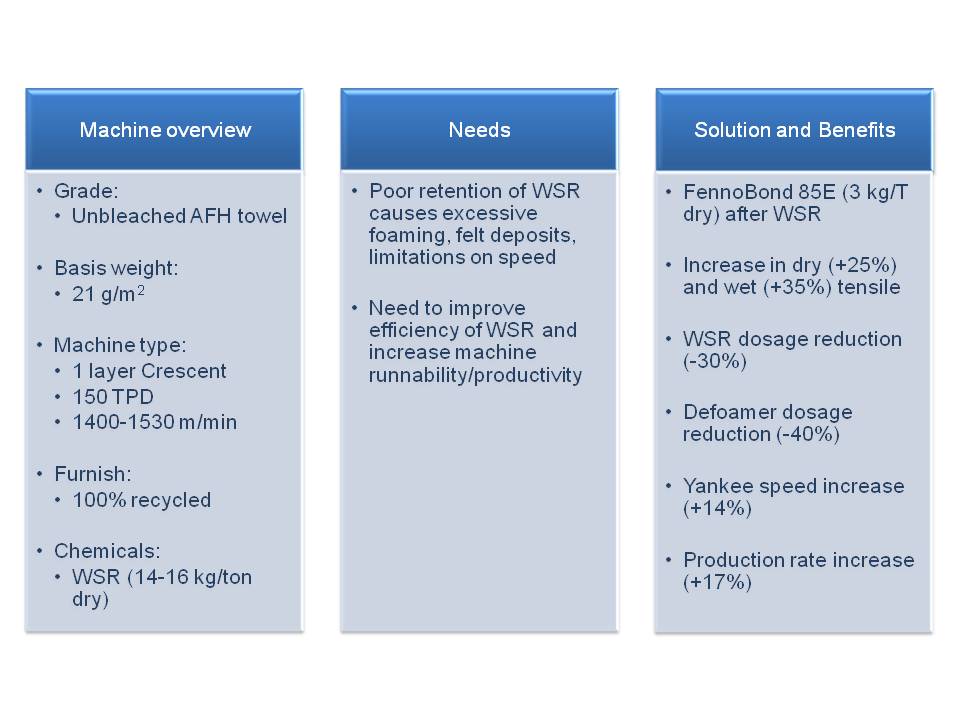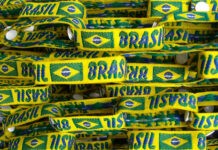Kemira’s Vladimir Grigoriev, Mikko Mäkinen and Roberto Zulian review the new developments in strength technologies and discuss the economic benefits found from industrial case studies.
The tissue market is one of the fastest growing segments of the paper industry. Globally, the average annual growth from 2000-2007 has been 3.6% for tissue compared to 1.8% for printing and writing grades [1]. Tissue production growth closely follows the increase in GDP and higher standards of living. The recent economic recession slowed down this growth, but the industry outlook is still positive largely due to continued growth in the emerging markets [2]. However, the industry
must find ways of maintaining acceptable profits in the current environment of consistently increasing fibre and energy costs, more stringent environmental regulations and consumer demand for higher quality at a lower price.
One performance target that can differentiate a tissue product is the sheet strength, which often involves a significant cost in order to achieve it. A careful balance between wet and dry strength is critical for achieving the targeted wet and dry tensile without a negative impact on softness and absorbency.
Of the number of means available for papermakers to control sheet strength, the choice of fibres and their mechanical treatment (refining) are the most common. Virgin fibres, especially Kraft softwood, produce the strongest sheet, but this pulp is costly. Driven by the high cost of virgin fibres and also by environmental pressure, the tissue industry has moved towards greater use of less expensive recycled fibres, which inherently produce a weaker sheet. Furthermore, the quality and availability of recycled fibres have been deteriorating dramatically in the latest decade or so, creating significant challenges for the industry [3].
Operational means such as headbox consistency or wet pressing can be effective in improving strength but can interfere with other objectives such as production rate or sheet bulk. In case of raw material or operation limitations, chemical means are often used as flexible and economical tools for strength control. A variety of strength chemicals are available in the market. In this paper, the chemistry of these strength aids is briefly reviewed with a particular focus on the acrylamide-based polymers. Their economic benefits for tissue production are demonstrated using mill trial results.
STRENGTH CHEMISTRIES
Various natural polymers and synthetic resins are employed for controlling sheet strength in tissue grades. The choice of a strength aid depends on a number of factors including their effectiveness, the programme cost, the effect on machine runnability and productivity, ease of use, product
availability and shelf life. The most common strength aids and their characteristics are summarised in Table 1.
The acrylamide-based polymers are especially versatile and have steadily been gaining market share in the past few years. The acrylamide-based strength aids include two main chemical classes:
solution polyacrylamide (SPAM) and glyoxalated polyacrylamide (GPAM), the characteristics and practical use of which are described below.
SPAM: VERSATILE AND EASY TO USE
Polyacrylamide is a common chemistry typically utilised in the wet end. Acrylamide-based products found use in water treatment, retention, dry and wet strength applications. The dry
strength improvement is primarily due to amide groups, forming hydrogen bonds with fibres and thus increasing inter-fibre bonding as shown in Fig. 1. Acrylamide-based polymers are very
versatile and can be manufactured within a wide range of molecular weight and charge.
For dry strength purposes, the molecular weight needs to be high enough to ensure efficient adsorption and hydrogen bonding, but not too high so the polymer would not cause overflocculation and poor formation, which can weaken the sheet [4]. These polymers are supplied as solutions in water and are referred to as solution polyacrylamide (SPAM). Cationic and amphoteric SPAMs are self-retaining on cellulose fibres, but can be sensitive to detrimental colloidal and dissolved substances (“anionic trash”). A high cationic charge (> 10 mole %) can overcome these problems although high cationic charge PAMs tend to be expensive due the high cost of cationic monomers. Food contact regulations (FDA, BfR), which are important for production of towel and napkin grades, also restrict the amount of a cationic monomer in SPAM.
Anionic SPAM requires a cationic counterpart for retention on fibres. Most commonly, anionic SPAM is used in combination with a cationic wet strength resin, resulting in synergistic effects on both wet and dry tensile. High cationic charge polymeric fixatives (polyamine, etc) can also be used for retention of anionic PAM. Kemira’s FennoBond 85E is an example of an anionic SPAM. It is a copolymer of acrylamide and acrylic acid. FennoBond 85E is especially effective when used in conjunction with a PAE wet strength resin.
Fig. 2 demonstrates that addition of high levels of the wet strength resin FennoStrength PA 21 causes overcationisation of fibres and limits further absorption of the resin, which is reflected in the plateauing effect on wet tensile already at 5 kg/tonne. Ineffective retention of a PAE resin can
lead to resin deposits, felt plugging and excessive foaming. Addition of anionic SPAM (FennoBond 85E) reverses the fibre charge to anionic, providing extra sites for retention of cationic PAE. This results in a wet tensile increase by additional 40%.
GPAM: DRY AND WET STRENGTH IN PAPER
Cationic glyoxalated polyacrylamide is a well-known strength resin [5-6] that is often regarded as a benchmark for generating dry strength. GPAM is a reactive polymer that can covalently bind with cellulose upon dehydration as shown in Fig. 3. The result is a generation of both dry and wet strength in paper.
The reaction with cellulose is reversible in water, making the wet strength temporary and has no impact on broke repulping. The design of the GPAM molecule can be altered to control the product efficiency and decay rate [7-9]. A slower decay rate is tolerable in towel grades, whereas a faster decay is required for manufacturing toilet paper that must be readily dispersed in water at room temperature.
MACHINE CASE STUDIES
Case study 1: Anionic SPAM in towel for chemical savings and increased productivity

A major tissue producer manufactures an unbleached folding towel using 100% recycled fibres. Wet and dry tensile are critical targets. A PAE wet strength resin (WSR) at 14-16 kg/ton (dry) is used to control wet tensile. No dry strength aid was used at the time. At such a high level of WSR, some of the resin was not retained, causing excessive foaming, felt deposits and other runnability issues. Most importantly, the foam was preventing the machine from running at a full
speed, limiting the production output.
Kemira offered anionic FennoBond 85E to help improve retention of WSR. Figure 4 summarises the trial results. As soon as FennoBond 85E was added to fibres, both wet and dry tensile increased above the target strength. This allowed for a decrease of the WSR dosage by up to 30% below
historical average. More efficient use of the WSR resulted in less foaming, a 40% reduction in defoamer usage and a speed increase of 14% as demonstrated in Figure 5. With an additional 3% decrease in the crepe ratio, the production rate increased by 17%. The impact of FennoBond 85E resulted in combined savings of around 26 €/t.

CASE STUDY 2: GPAM STRENGTH AID FOR FIBRE AND CHEMICAL SAVINGS
A tissue mill producing unbleached white towel from 100% recycled white fibres was having difficulties with meeting the dry tensile
specifications. Due to low dry tensile, the converting efficiency has especially suffered from frequent breaks. The use of CMC to control dry strength had limited success.
Furthermore, the tissue producer had received complaints from their customers about the odour that seemed to be associated with the use of CMC.
Kemira offered FennoBond 3000 (GPAM resin) in combination with FennoStrength (PAE resin) to resolve this issue. Figure 6 summarises the
customer situation and the trial results. Replacing 1,5 kg/t CMC with 1,4 kg/t FennoBond 3000 (dry basis) resulted in an increase in both dry
tensile and wet tensile by 22 and 45%, respectively. Improved dry and wet strength allowed for a 15% reduction in the sheet grammage and
a 14% decrease in the wet strength resin consumption. The overall equipment efficiency (OEE) increased from 21 to 60%. The realised savings are estimated at around 19 €/t. In addition, there have been no customer complaints about the towel odour since switching from CMC to
FennoBond 3000.

CASE STUDY 3: GPAM STRENGTH AID FOR DUST CONTROL AND ENERGY SAVINGS
A tissue mill produces a kitchen towel from 100% bleached virgin fibres. The mill has stringent requirements for a low level of dust in the base sheet due to a negative impact on converting efficiency. The mill uses refining and enzyme for dry tensile control. A PAE wet strength resin combined with an anionic SPAM are used to provide wet tensile.
Kemira offered FennoBond 3000 for dust control. Figure 7 summarises the trial results. The addition points of the wet end additives and their dosages had to be optimized to ensure effective retention of all chemicals.
After optimisation, the sheet quality was at or above target. The dry tensile was significantly increased, allowing for a reduction in refining energy by 37%, which more than offset the cost of FennoBond 3000. Improved dry strength and reduced refining resulted in less dust during production. The subsequent evaluation of dust generation in converting has shown no significant dust.

CONCLUSIONS
Strength additives are critical components for tissue manufacturing. They can provide not only the required strength quality to tissue products but can also improve process efficiency and machine productivity, resulting in significant profit gains. A variety of strength chemistries are available in the market, including natural polymers (starch, CMC) and synthetic resins (SPAM, GPAM, PAE). The acrylamidebased resins have been gaining the market share due to their unique benefits, ease of use and versatility. The documented benefits of using these strength aids include improved sheet characteristics (strength, bulk), reduced basis weight, a larger use of lower quality fibres, energy savings, increased machine speed, productivity gains and reduced consumption of other chemicals (e.g., wet strength resin, defoamer).
Vladimir Grigoriev is Kemira’s product launch manager, FennoBond, paper applications, EMEA; Mikko Mäkinen is a senior research scientist, fibre and wet-end; and Roberto Zulian is manager, business development EMEA – MD Italy
[box]
References
- G. Ionides “Market outlook” in Paper 360, May 2008, pp. 8-10.
- M. Persson “Expect some slowdown” in Pulp & Paper International, January 2011, pp. 11-13.
- I.Cabalova, F. Kacik, A. Geffert and D. Kacikova. “The Effects of Paper Recycling and its Environmental Impact” in “Environmental Management in Practice”; E. Broniewicz (Ed.), InTech, 2011.
- T. Linström, L. Wågberg and T. Larsson “On the nature of joint strength in paper- A review of dry and wet strength resins used in paper manufacturing” in “Advances of paper science and technology”, Transactions of 13th Fundamental ResearchSymposium, v.1, pp. 457-56.
- “Wet- and dry-strength additives – application, retention and performance”, G. G. Spence (Ed.), TAPPI Press, 1999.
- “Wet strength resins and their applications”, L.L. Chan (Ed.), TAPPI Press, 1994.
- US Patent 5723022, D.L. Daulplaise and G.J. Guerro (Inventors), 1998.
- US Patent 7964669, R.J. Proverb and L.M. Pawlowska (Inventors), 2011.
- US Patent Application 2012/0080157, S. Rosencrance, Y. Luo and V. Grigoriev (Inventors), 2012. Acknowledgements Authors are grateful to Ghislain Lemay and Jordi Sanchez for valuable contributions to this paper.
[/box]






























